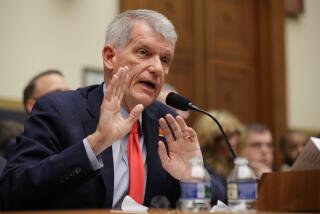CEO Tim Sloan has had two years to fix Wells Fargo. Is he running out of time?
More than two years after Wells Fargo & Co. said it had created perhaps millions of unauthorized customer accounts, the scandal ignited by that admission has more than persisted ‚ÄĒ it‚Äôs spread, raising questions about how long Chief Executive Tim Sloan can keep his place atop the troubled lender.
Critics, notably Sen. Elizabeth Warren (D-Mass.), have repeatedly pushed the bank to fire Sloan, saying his 31-year tenure with the San Francisco bank means he knew or should have known about problems long ago. And calls for a new chief executive aren’t likely to die down given new developments over the last year.
The bank has been hit with additional federal enforcement actions, including a $1-billion fine and an order to stop growing until it can show it has addressed its problems. This spring, it acknowledged it had foreclosed on hundreds of homeowners after improperly denying them mortgage modifications.
And last month the bank put two high-level executives on leave and removed them from a key leadership committee, reportedly because of pressure from regulators ‚ÄĒ potentially a sign that regulators believe Sloan has not done enough to clean house since taking over the top post shortly after the scandal broke in September 2016.
The bank has said only that Chief Administrative Officer Hope Hardison and Chief Auditor David Julian were on leave because of ‚Äúpreviously disclosed ongoing reviews by regulatory agencies in connection with historical retail banking sales practices.‚ÄĚ
Now, with Democrats winning control of the House of Representatives, and Wells Fargo critic Rep. Maxine Waters expected to take over as chair of the House Financial Services Committee, analysts say it’s likely Sloan will be called to testify before that panel.
As with former CEO John Stumpf ‚ÄĒ who stepped down shortly after a pair of bruising Capitol Hill appearances weeks after the bank was hit with a $185-million fine over the unauthorized accounts ‚ÄĒ a new round of congressional hearings could help decide Sloan‚Äôs fate, said Ed Mills, a public policy analyst at financial services firm Raymond James.
‚ÄúI think the wild card here really is if and when that hearing comes,‚ÄĚ Mills said. ‚ÄúUnless you show up and are able to go on the offensive and come through with a solid performance that reestablishes confidence in you from investors, Congress and the regulators, then you‚Äôre probably going to be forced to make additional changes.‚ÄĚ
Rumblings about Sloan’s potential ouster started in September, when the New York Post reported that the bank’s board had tried to recruit former Goldman Sachs executive and Trump administration economic advisor Gary Cohn as a potential replacement for Sloan. Wells Fargo Chairwoman Betsy Duke denied the report and said Sloan had the board’s support.
‚ÄúRumors that Wells Fargo‚Äôs Board of Directors reached out to potential CEO candidates are completely false,‚ÄĚ Duke said in a statement at the time. ‚ÄúCEO Tim Sloan has the unanimous support of the board, and this support has never wavered.‚ÄĚ
In response to questions from the Los Angeles Times last week about Sloan’s tenure, Wells Fargo spokeswoman Arati Randolph said the chief executive has made a bevy of changes at the bank and remains committed to improving its practices.
‚ÄúUnder his leadership, the company has completed a number of comprehensive third-party reviews and made fundamental changes to retail sales practices,‚ÄĚ she said in a statement. ‚ÄúTim is committed to transparency and is focused on closely examining our company, fixing issues we find, and making things right for our stakeholders.‚ÄĚ
Waters told The Times this month that she expects to meet with Sloan to discuss the bank‚Äôs ongoing problems and that, after that, hearings are possible. ‚ÄúWells Fargo has emerged with the kind of problems that lead everyone to wonder what is going on over there,‚ÄĚ she said.
Although a bad performance could be bad for Sloan personally, it could have even greater implications for the bank ‚ÄĒ including an extension of the asset cap ordered by the Fed in February.
Before it lifts the asset cap, the Federal Reserve board must hold a formal vote on the matter ‚ÄĒ something Fed Chairman Jerome H. Powell agreed to after pressure from Warren. Mills said the prospect of such a vote going Wells Fargo‚Äôs way, at least in the short term, seems less likely if the Financial Services Committee reengages in hearings or investigations.
‚ÄúNo regulator wants to go before a committee and explain why they‚Äôre letting the bank off the hook,‚ÄĚ Mills said. ‚ÄúIn politics, one of the first lessons I learned is when you‚Äôre explaining, you‚Äôre losing.‚ÄĚ
Wells Fargo executives initially said they hoped to be out from under the Fed’s asset cap by this fall. Later, Sloan said he expected to operate under the cap into 2019. Now, analysts say they expect the cap to stay in place for most of the coming year.
Not everyone on Wall Street thinks the risks of Capitol Hill hearings are all that dire.
Brian Kleinhanzl, an analyst at Keefe, Bruyette & Woods, expects hearings and said they could lead to more rough headlines, but these days that amounts to business as usual.
‚ÄúIt‚Äôs par for the course for Wells Fargo,‚ÄĚ he said. ‚ÄúWe don‚Äôt view it as a big, long-term risk.‚ÄĚ
He noted that the asset cap does not seem to be causing much harm. If other banks were growing rapidly and taking market share away from Wells Fargo, which for now doesn’t appear to be the case, investors would be more concerned, he said.
‚ÄúYou‚Äôre not seeing industry growth that‚Äôs strong enough for the asset cap to come into play,‚ÄĚ he said. ‚ÄúThe earnings impact is limited.‚ÄĚ
Political calculus aside, there may be plenty of reasons for the bank’s board to leave Sloan in place for now. Nearly all of the bank’s revelations over the last two years relate to practices that were in place before Sloan became CEO, said Robert Hockett, a Cornell law professor and expert on financial regulation.
‚ÄúThey might say, ‚ÄėLook, the problems were so massive, so deeply rooted, that it was bound to be the case that more problems would come to light,‚Äô ‚ÄĚ he said. ‚ÄúFor that reason, they could be patient with Sloan.‚ÄĚ
Jeffrey Sonnenfeld, an associate dean at Yale School of Management, said pressure to remove Sloan is misguided. He said it could take years for a new chief executive to get up to speed on the bank’s issues and that, in general, it’s better for an insider to handle corporate turnarounds.
‚ÄúTim Sloan is squeezed by his association with the past, but he is not the bad guys of the past,‚ÄĚ Sonnenfeld said. ‚ÄúThe old Rastafarian proverb goes, ‚ÄėA new broom sweeps clean, but old brooms know the corners.‚Äô Sloan knows the corners.‚ÄĚ
Sloan was appointed president and chief operating officer about a year before his elevation to CEO and previously served as the bank’s chief financial officer, chief administrative officer and in other top roles. He has said he was aware of the troubling sales practices as early as late 2013, when a Times investigation first publicly revealed the problems.
Sonnenfeld also said that regulators‚Äô apparent rebuke of two of Sloan‚Äôs top lieutenants isn‚Äôt necessarily a sign that Sloan himself is in trouble. Rather, he said it could be a sign that regulators either uncovered new information or simply wanted to show ‚Äúa symbolic token of progress.‚ÄĚ
The bank has taken numerous steps to address problems, including changing a system of incentives and onerous sales goals that led workers to open unauthorized accounts. It also revoked tens of millions of dollars in compensation for Stumpf and Carrie Tolstedt, a former bank executive who bore much of the blame for the accounts scandal in a report commissioned by Wells Fargo’s board.
The bank also started a wide-ranging review of practices, which led to revelations of more bad practices. Still, if more problems continue to emerge, whether they began before or after Sloan’s move to the corner office, patience with the CEO could quickly wear thin, Hockett said.
‚ÄúAt some point, the ‚Äėit takes awhile to root it out‚Äô idea begins to grow less plausible,‚ÄĚ he said. ‚ÄúIf more scandals emerge, even if they‚Äôre old, the fact that more are coming out and that there hasn‚Äôt been enough outwardly visible, dramatic actions will probably combine to harm him.‚ÄĚ
Bank analyst Bert Ely agreed, saying that the bank’s turnaround, even for a company of its size, seems to be taking a long time and that the regular stream of new problems is probably wearing on investors.
The bank’s stock has lagged behind that of other banks in the years since the scandal first erupted. Since September 2016, Wells Fargo’s stock has climbed about 8% while the KBW-Nasdaq Bank Index, which tracks national and large regional bank stocks, is up 38%.
‚ÄúThe bank has done a lot. They‚Äôve put a lot of problems behind them, put new people in place ‚ÄĒ but still, problems keep surfacing,‚ÄĚ Ely said. ‚ÄúIt‚Äôs like, when is it going to end?‚ÄĚ
He speculated that Sloan, through no fault of his own, may not remain CEO much longer. If the bank gets to a point where it feels most old problems have been dealt with, it might look for an executive who is not connected to the bank’s previous sins.
‚ÄúIs Sloan the guy to stay there for the long term?‚ÄĚ Ely said. ‚ÄúHe‚Äôs somewhat damaged goods politically. Maybe he‚Äôs a transition from the way they used to do business to the way they should be doing business. And they may be at that point.‚ÄĚ
Follow me: @jrkoren
More to Read
Inside the business of entertainment
The Wide Shot brings you news, analysis and insights on everything from streaming wars to production ‚ÄĒ and what it all means for the future.
You may occasionally receive promotional content from the Los Angeles Times.











